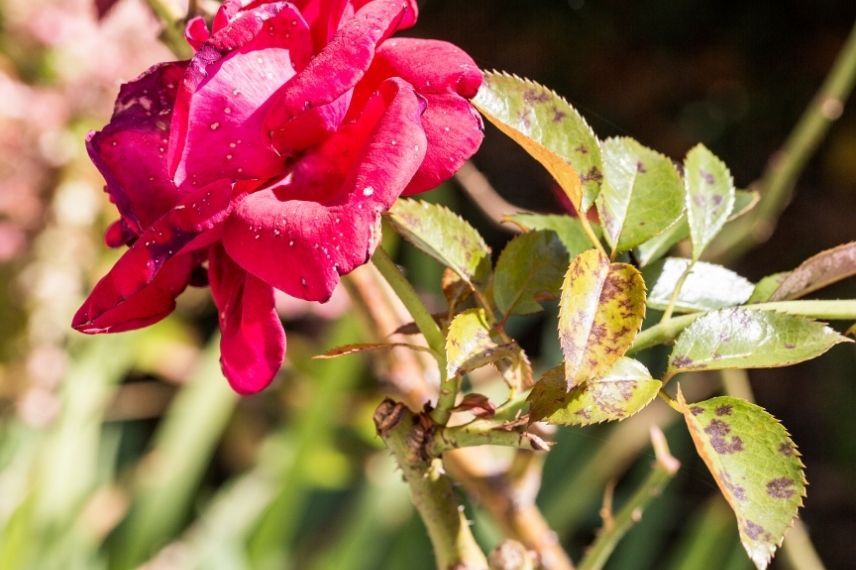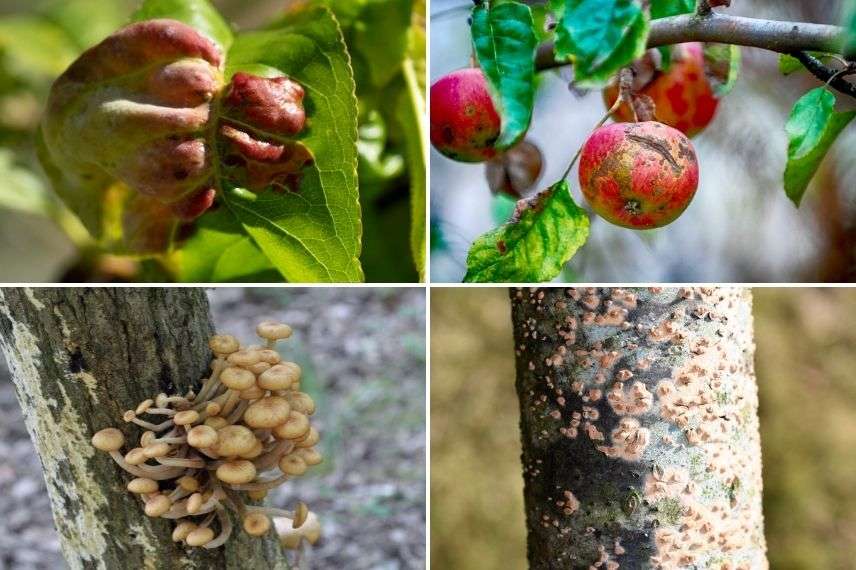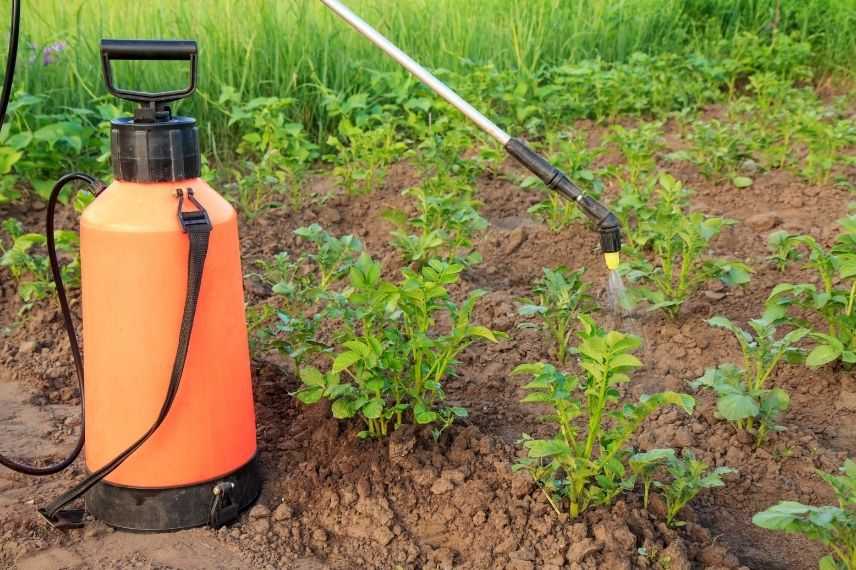
All you need to know about fungal diseases
Identify different fungi, prevent their occurrence, and treat your plants naturally
Contents
Fungal diseases, or cryptogamic diseases, are illnesses caused by fungi that parasitise plants. They are the most commonly encountered diseases in ornamental gardens, orchards, or vegetable plots.
Some simple preventive measures can help limit their occurrence. Once the first symptoms are spotted, it is sometimes still possible to act to limit the development of diseases and prevent the proliferation of fungi.
Let’s take a closer look at these diseases, to better identify and treat them naturally.
Definition of a cryptogamic disease
Fungal diseases are the result of a plant being contaminated by a parasitic fungus. They represent the largest proportion of diseases encountered in the garden and affect almost all plants: annual plants, perennials, bushes, trees, ornamental plants, or vegetable and fruit plants. Among the most sensitive subjects are roses, tomatoes, potatoes, vines, apple trees, and pear trees, for example.
Dissemination occurs through the spores of fungi, which can be carried by wind, rain, animals, or even by gardeners themselves. Spores may also still be present in the soil following a previous contamination. This mode of reproduction makes them highly contagious diseases from one plant to another.
Spores enter the plant in several ways:
- through its natural openings (stomata of leaves, lenticels)
- through wounds caused by insect attacks, following pruning, injuries caused by wind or frost, etc.
- through the roots
Some fungi can even penetrate the protective layer (cuticle) of the plant’s aerial organs. Once the fungus is established, after an incubation period, it develops through filaments (mycelium) by germinating rapidly and branching between the cells. It is at this point that the first symptoms of the disease appear.
In the long term, tissues undergo necrosis, sap does not circulate properly, and vessels become blocked. The consequences are not always fatal, but they lead to the weakening of the affected plant, sometimes to the point of its decline, and a reduction or even loss of the crop.

Roses are particularly sensitive to fungal diseases.
The main fungal diseases
Some of these diseases are particularly common in the garden. They can be identified by the more or less coloured spots that appear on the aerial parts of the plant or by characteristic deformations.
- Downy mildew generally affects tomatoes, potatoes, onions, vines, and roses. It causes brown spots or mould, sometimes surrounded by yellow on the leaves. A white fluff may also appear. The fungus eventually leads to the drying out and rotting of the plant.
- The grey mould or botrytis is found in the vegetable garden (strawberries, courgettes, melons,…) as well as in the ornamental garden (roses, geraniums, primroses,…) or in the orchard (raspberries, apple trees,…). It is identified by the appearance of spots covered with a grey fluff on the leaves, flowers, and fruits, leading to their rotting.
- The powdery mildew is very common on roses, vines, fruit trees, and vegetable plants such as squashes or borage. It appears as a white-grey powdery fluff that covers all parts of the plant. The first symptoms generally appear on the leaves and stems, then on new shoots, flowers, and fruits, which turn brown, dry out, and fall prematurely. On ornamental plants, the issue is mainly aesthetic, but in the vegetable garden, the harvest can be affected if the disease occurs early in the season.
- The monilia: this fungus parasitises fruit trees (apricots, almonds, cherries, peaches, pears, plums,…), attacking the branches, flowers, and flower buds. It causes the fruits to rot, which then mummify on the tree while remaining attached.
- The rust affects many plants, from ornamental plants (roses, hyacinths, hollyhocks,…), to vegetables (beans, garlic,…) or fruit trees (pear trees, currant bushes,…). It is identified by its pustules of different colours depending on the species, often orange, yellow, or brown, that appear on the foliage. The leaves become deformed and fall prematurely.
- Marsonia or black spot disease appears on flowering plants such as roses or on fleshy fruit plants like grapes or strawberries. It forms round spots with yellow edges on the leaves. The flowers wilt, the foliage dries out, the stems and branches eventually die, and the roots rot.

Botrytis, powdery mildew, monilia, and marsonia.
- The leaf curl affects fruit trees such as peaches, nectarines, or apricots. The leaves become swollen, curl, and change colour. The fruits may also become deformed. The branches weaken and the affected plants deteriorate over time.
- The scab affects apple and pear trees, as well as ornamental plants like willows or hawthorns. It causes irregular brown or black spots on the leaves, which eventually fall. It can also create crusts and cracks on the fruits, halting their development.
- The honey fungus affects trees and shrubs (mulberry, hornbeam, birch, fir, oak, beech,…). It appears at the base of the trunk after contaminating the root system. Leaves and branches dry out, the plant emits a mouldy smell, and eventually perishes.
- The coral disease attacks various trees and shrubs (maples, albizias, linden trees, magnolias,…), as well as fruit trees (apple trees, plum trees, cherry trees,…). It is easily identified by the presence of pustules and small clusters of coral-coloured balls. This fungus leads to the deterioration of branches and twigs and, in cases of severe infestation, the decline of the plant.
- Damping off can affect all sown plants. Either the seeds do not germinate, or the stems of the seedlings stretch and turn brown before dying.

Leaf curl, scab, honey fungus, and coral disease.
Preventing fungal diseases
The ideal cocktail for the appearance and development of fungi is a combination of heat and humidity. Spring and autumn are the most conducive seasons for these diseases, when temperatures soften, rising above 10-12°C, and rainfall and ambient humidity become more frequent.
However, a few simple actions can help limit the appearance or development of these diseases.
- Avoid wetting the foliage of your plants during watering
- Always clean and disinfect your cutting tools before pruning to prevent the transmission of spores between plants
- Ensure good ventilation between plants by respecting the recommended spacing to allow air to circulate properly and prevent humidity from stagnating in the foliage
- Practice crop rotation and diversify varieties: monoculture tends to deplete the soil, destabilise it, and promote the appearance of diseases
- Avoid leaving plants with open wounds, which are gateways for fungi. You can use healing paste after pruning.
- Do not grow sensitive plants in previously infected areas
- In humid climates, grow the most sensitive plants in a greenhouse or shelter, such as squashes or tomatoes
- Grow varieties known to be resistant to diseases: ADR-certified roses, apple trees of the variety ‘Ariane’ or ‘Reinette Grise du Canada’, ‘Honey Moon’ tomato resistant to blight, etc.
- Care for the growing conditions: promote soil drainage, fertilise appropriately, water regularly, etc. Healthy plants, whose cultural needs are met, will be more resilient. They will be less likely to develop diseases or be susceptible to fungal attacks
- Regularly observe your plants to act at the first signs by removing contaminated parts

Proper watering, disinfecting pruning shears, and observing plants are fundamental actions to prevent the appearance of fungal diseases.
Read also
Diseases of rosesTreating fungal diseases naturally
When symptoms appear, there is not really a treatment for fungal diseases. However, natural solutions can help prevent the spread of fungi to the rest of the plant or to neighbouring plants.
The first step is to remove the diseased parts of the plant. You can dispose of this green waste by burning it, if permitted in your area, taking it to a waste disposal site, or composting it. Note that some gardeners advise against composting diseased plants, while others believe that a properly balanced compost heats up sufficiently to eliminate diseases and fungi naturally.
Even at the end of the season, do not leave any fruit, leaves, or diseased branches on your plants.
Plant manures
Although their effects are not scientifically proven, plant manures are said to have a beneficial effect against fungal diseases. On one hand, they help strengthen the plant’s natural defenses; on the other hand, they limit the proliferation of fungi.
Manures are often used as natural treatments in organic gardening, both preventively and curatively, as a replacement for chemical products.
Horsetail manure strengthens the plant’s immune defenses due to its richness in minerals. Horsetail is also said to have antifungal properties at the first signs of fungal diseases, particularly in fruit trees. It should be used diluted and applied as a spray from spring until harvest, at least every 15 days. You can purchase a ready-made horsetail manure solution or make it yourself, by following our advice in the dedicated article: How to make horsetail manure?
Nettle manure has similar properties to horsetail manure: it stimulates the natural defenses of plants and may help prevent diseases. It should be used diluted as a spray on the affected parts. Again, you can choose to buy nettle manure in stores or easily make homemade manure, by following our tutorial: How to make nettle manure?
Fern or tansy manures are also used to combat fungi. Fern manure is said to have both curative and preventive effects against rust and powdery mildew. Tansy manure, on the other hand, may help limit the appearance and development of potato rust and downy mildew. For more information, feel free to consult our articles How to make fern manure and How to make tansy manure.
Bordeaux mixture
The Bordeaux mixture is a copper-based solution used as a fungicidal treatment. It is usually a blue powder to be diluted in water. It acts preventively by preventing the germination of fungal spores, as well as curatively by limiting the development of the disease.
The Bordeaux mixture can be used in ornamental gardens, vegetable gardens, or orchards, as its action is effective against most fungal diseases: downy mildew, grey rot, moniliosis, leaf curl, scab, etc.
This product is permitted in organic farming but should still be used sparingly. An excessive amount can lead to harmful imbalances in the soil and environmental pollution.
For more information, we invite you to read our article: Bordeaux mixture and other copper-based treatments in the garden.

Other antifungal treatments
Bicarbonate of soda, valued for its many uses at home and in the garden, may help combat the fungi responsible for scab and powdery mildew. Bicarbonate of soda is used as a spray once diluted in water, preventively before the first symptoms appear in spring and summer. This product is usable in organic farming.
Sulphur also has fungicidal properties, which may help prevent powdery mildew, downy mildew, and scab. It is applied as a powder on the affected plants, before the first symptoms or at the onset of the attack.
These products, although natural, should still be used sparingly: excessive amounts can ultimately disrupt the soil and natural biodiversity, thus promoting the development of diseases. A true vicious circle that no gardener wants to encourage!
- Subscribe!
- Contents
































Comments